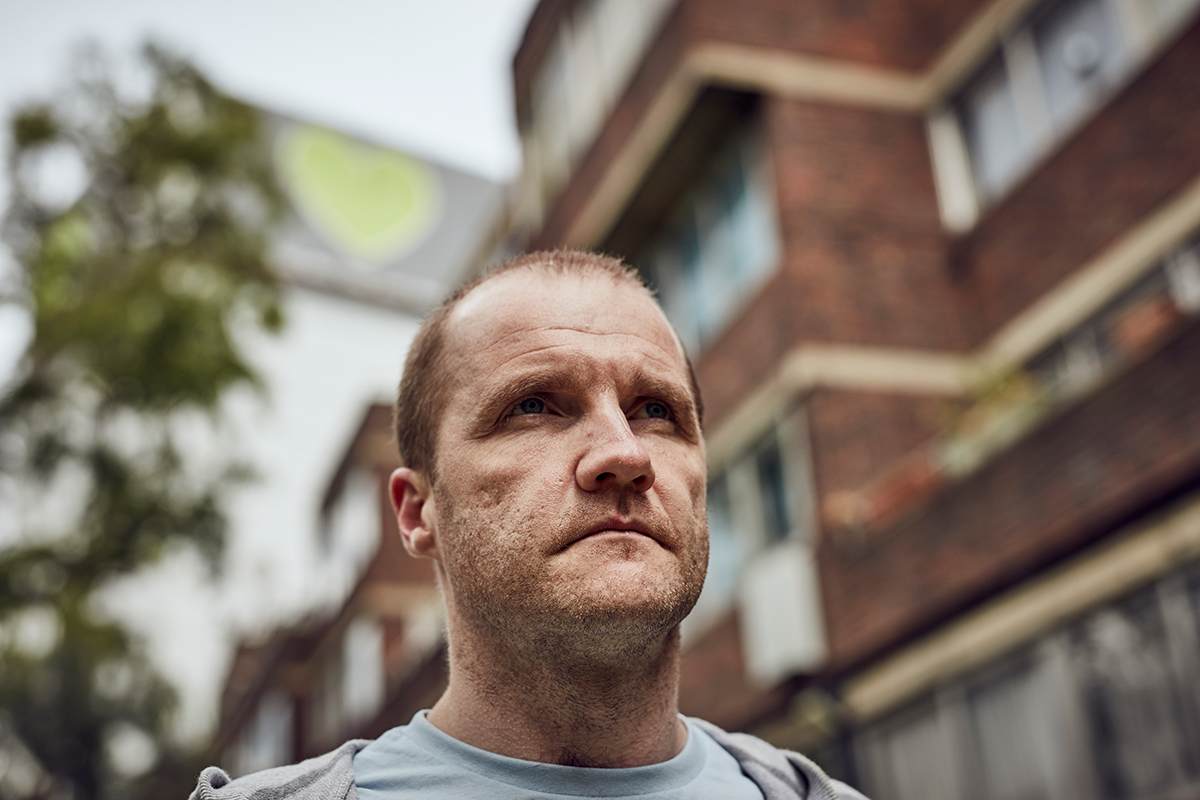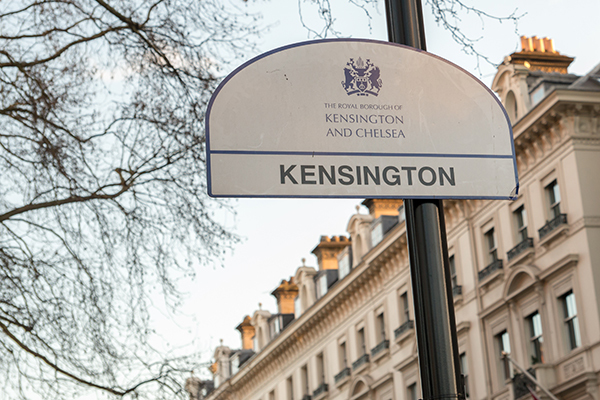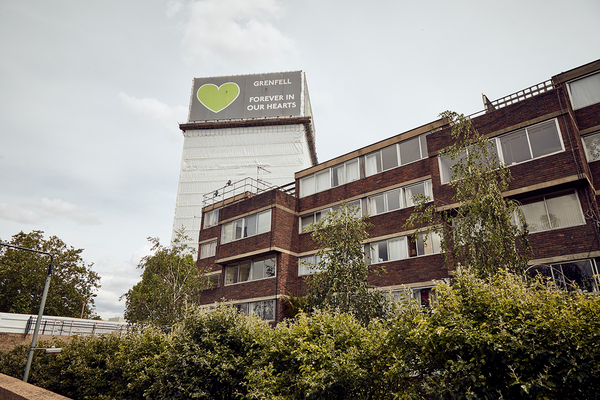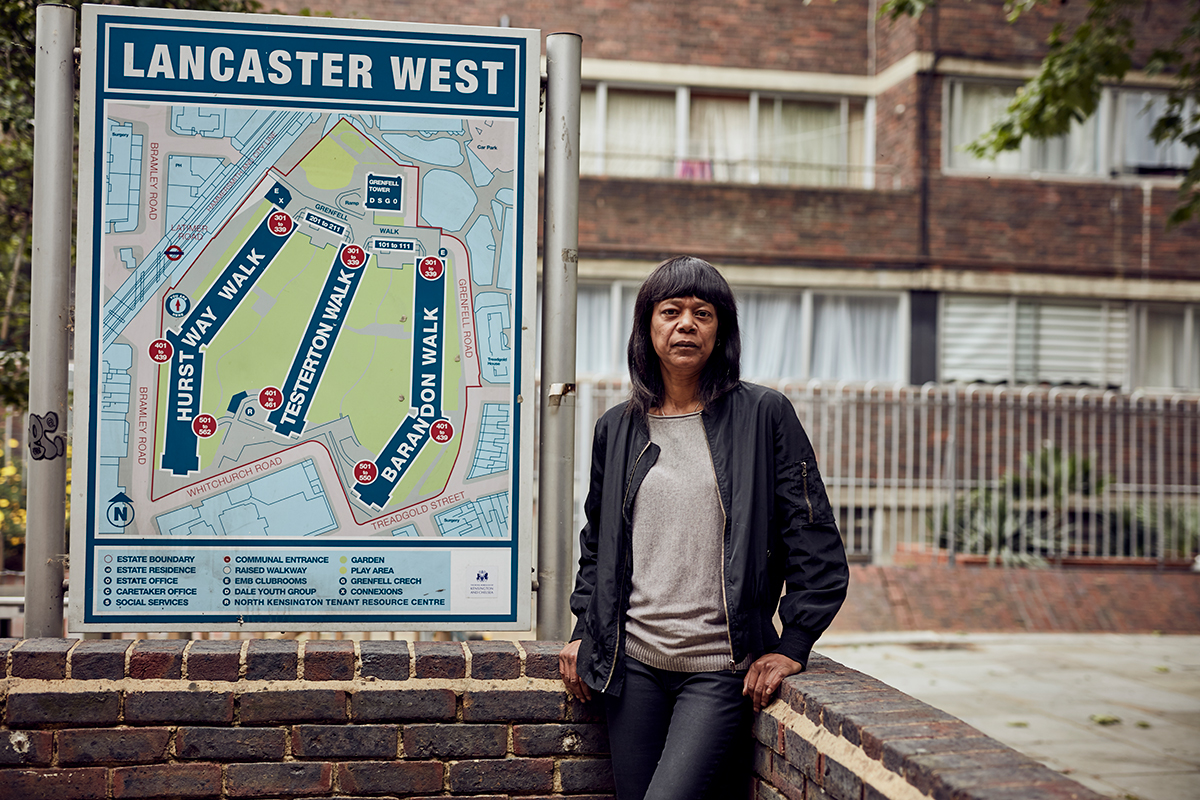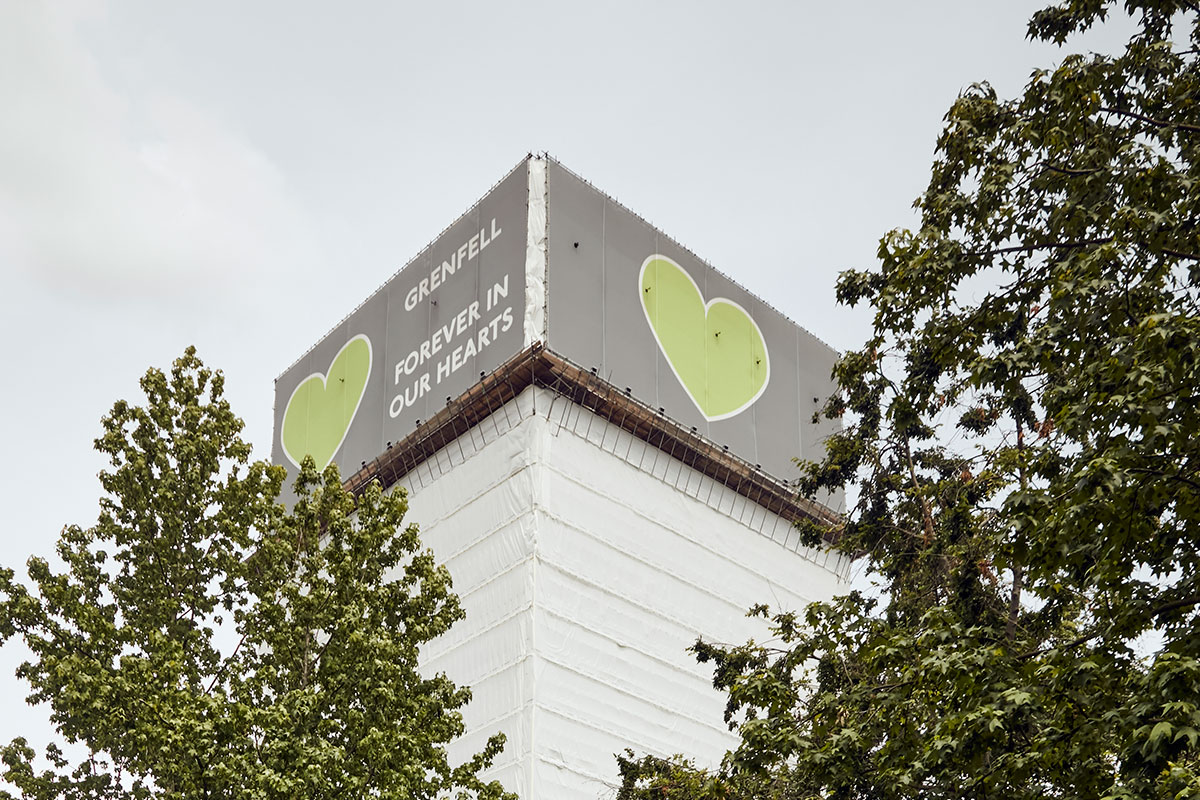You are viewing 1 of your 1 free articles
Grenfell’s forgotten victims: life on the Lancaster West Estate after the fire
Residents of the flats surrounding Grenfell Tower have been through a housing crisis like no other – many diagnosed with PTSD as a result. Luke Barratt hears some of their stories. Photography by Jon Enoch
Picture: Joe Delaney, a former resident of the 300s
Wherever you go in North Kensington, it is difficult to avoid Grenfell Tower.
Nowhere is this truer than on the Lancaster West Estate. Here, three low-rise ‘finger blocks’ containing 795 homes stretch south-west, away from the tower’s base.
Grenfell itself, where a catastrophic fire killed 72 people in 2017, looms large over the whole estate. The tower is now covered in white plastic sheeting with a huge green heart emblazoned at the top, alongside the words “Grenfell: forever in our hearts”.
The three low-rise blocks – Barandon Walk, Testerton Walk and Hurstway Walk – are collectively known as the Walkways. The flats closest to Grenfell Tower are known as ‘the 300s’.
A great deal has been written about the rehousing process for the 201 families who survived the fire, but the disaster was further reaching than many realise.
For Walkways residents and many others in the surrounding area, 14 June 2017 signalled the start of a housing crisis like no other, as grief for their friends and families and struggles with mental health combined with the cold, hard realities of the west London housing market.
On the night of the fire, many of Grenfell’s closest neighbours were told to evacuate. Flaming debris was falling onto people’s balconies and there were fears that the tower could collapse.
Joe Delaney, a former resident of the 300s, recalls the night: “We were told to get out of the building. We weren’t allowed to return until the Sunday or Monday following the fire. [For] five or six days we weren’t allowed back.”
Mr Delaney says that no one he knows on the estate was offered accommodation in those first few days. He went to stay with a friend but not everyone was so lucky.
“There were people sleeping on the grass outside the estate,” he recalls.
Emma Dent Coad, MP for Kensington, tells a similar story: “In the early days, there were people sleeping under bushes and in parks. I know two or three people who were sleeping in their cars.”
In response, a spokesperson for the Royal Borough of Kensington and Chelsea (RBKC) stresses that the priority in the immediate aftermath of the fire was to look after families from the tower.
However, they add: “A housing officer did walk around the site on the first night and speak to police officers about any rough sleeping and no one was seen.”
Like many from the tower itself, Walkways residents were initially put up in hotels. At this point, council policymakers went to work on a rehousing policy. Residents of the tower itself and of Grenfell Walk, the small buildings at the foot of the tower made totally uninhabitable by the fire, were put into Category A and awarded 3,000 points on RBKC’s homelessness waiting list, sending them right to the front of the queue.
Although issues with the process have been well documented and more than one promised deadline for finishing it has passed, 184 of the 201 families in this category have now moved into permanent homes.
Category B was for everyone else, although reliable numbers in this area are hard to come by. RBKC awarded 129 families ‘wider Grenfell rehousing priority’, meaning they received 900 points. This put them above most homeless people in the borough but below Category A residents.
Spike Western, a paralegal at North Kensington Law Centre, which is located in the Walkways, says he does not think this accounts for everyone made homeless by the Grenfell fire. The policy, he explains, includes the three Walkways blocks as well as nearby Bramley House and Treadgold House but not any of the other surrounding buildings.
Mr Western says that around a third of his clients are “people who have been made homeless by the fire but don’t fall under the policy, mainly because of where they live”.
He estimates that close to a thousand households have come forward to tell the council that they are homeless as a result of Grenfell. The council says this is “absolutely not” the case but was unable to provide a figure.
Government statistics show that the number of families on RBKC’s waiting list leaped from 2,718 in April 2017 to 3,330 the following year. According to Mr Western, families have continued to come forward since then, meaning RBKC’s 129 households are unlikely to tell the full story.
Whatever the final count, how could so many families be homeless as a result of a fire that destroyed one 23-storey block? Mr Western says that many families would have wanted to move even if their homes were intact. “Grenfell Tower was the heart of the estate,” he explains. “Everybody would have known each other’s faces.”
Mr Delaney, who has since moved into a new flat elsewhere in the borough, adds: “I never look at the tower. Even now it’s covered, I don’t look at it. I don’t think it should have been covered, personally. I think it had more of an impact when it wasn’t covered.
“But I never used to look at it. I never liked being back there. I just couldn’t do it. Even now I spend as little time around there as possible.”
Mr Western says that all his clients have been diagnosed with post-traumatic stress disorder (PTSD); he has received training from the Grenfell Health and Wellbeing Service on dealing with the condition.
Jacqui Haynes, who was until recently chair of the Lancaster West Residents’ Association
He explains: “The first stage [to recovery] is providing a safe space. It’s really difficult to provide that safe space when you’re surrounded by triggers. Living next to the burned-out shell that was once the heart of the community is a major trigger.”
Because of this, many residents – particularly those from the 300s – do not want to move back.
The council, however, has not made this easy. As Inside Housing reported in September last year, it decided to impose a deadline on Walkways residents for deciding whether to move home from their temporary accommodation.
RBKC wanted residents to relinquish their Walkways homes or move out of their temporary accommodation. After receiving letters from the council about this, residents feared that they could be charged rent on both their temporary accommodation and their Walkways home.
The letter, seen by Inside Housing, told residents: “If you choose not to return home and you remain in temporary accommodation after the end of September, you will start to pay rent for your temporary home from 22 October 2018. You will no longer pay rent for your council home.”
It did not clarify what would happen to residents who did not make decisions in time for the deadline. Nevertheless, councillor Judith Blakeman says she spoke to households who had been told by council officers that they could have to pay rents on two properties.
The council insists that “literature and face-to-face dealing made clear from the start no one would have to pay for two properties”.
They also say that the idea of imposing a deadline on residents in temporary accommodation was “discussed and due to become policy in September [2018]” but later dropped.
For one 300s resident, however, the uncertainty was too much. She moved back to the Walkways, only to find herself the only one living on her floor.
“The problem is, there are no neighbours,” she says. “There is nobody here. I didn’t know, when I signed the papers saying I wanted to come back, the state the place was going to be in.”
Although she and her children have been diagnosed with PTSD and she lost a friend in the fire, she says no one told her that moving back to the estate could be triggering.
“You feel like it’s going to fall on you,” she continues. “I feel like crying every day. Every day in this place, my skin is up. The children tell me, ‘Mama, I saw a ghost.’”
She says she told the council she has changed her mind and still wants to be rehoused. RBKC has reinstated her wider Grenfell rehousing priority and given her 900 points, but she says she has not been allowed to return to her temporary home.
Let down: stories of rehousing
One of the Walkways buildings on the Lancaster West Estate
Residents and those helping with the rehousing effort are practically overflowing with stories of people who have been failed by the process. Here are some of them:
- One resident from Grenfell Walk was initially put in a hotel in Shepherd’s Bush, opposite a tower block where a fire spread up six floors along the outside of the building. The resident’s window looked directly onto the still-scorched exterior of the tower.
- One Walkways resident, still in temporary accommodation at the time of writing, has been moved from one temporary home to another 16 times.
- Another Walkways resident, initially moved to a hotel, has been forced to move back after they became unable to afford the temporary accommodation they were moved to. They are now living on the Walkways despite having initially moved out because of mental health concerns.
- One resident was offered a flat with no floorboards in the kitchen.
- Joe Delaney says that the council attempted to convince him to put his two dogs in kennels in Heathrow rather than find dog-friendly hotels, something he managed to do himself.
The council says that anyone “placed somewhere they felt was inappropriate because it caused them distress” was later moved.
“We were tricked into going back,” she insists. “They told me everything will be perfect but this place is not liveable.”
Three-bedroom council homes, like the one she needs, are few and far between in Kensington and Chelsea. Although the council bought 325 homes after the fire, these were primarily for former residents of the tower.
As Inside Housing revealed in February, just one four-bedroom home has become available in the borough in each of the past two financial years.
For residents who do not have the 900 points, rehousing can be even harder. Another way for residents to climb the waiting list is to apply for medical priority.
Medical priority for rehousing is awarded to people whose housing is directly causing them medical difficulties. Given the widespread diagnoses of PTSD, it is perhaps unsurprising that figures released to Inside Housing under the Freedom of Information Act show that 100 households received medical priority in 2018/19, significantly more than the 61 from the previous year or the 66 from the year before that.
But the bar for medical priority seems to be set high. In a letter – seen by Inside Housing – sent by RBKC to a resident last September, the council said that residents would need to demonstrate “severe and enduring health problems that are significantly, directly and adversely affected by their current accommodation”.
According to Mr Western, the threshold has been very difficult to reach, even when medical evidence is available. RBKC says there has been no change to its assessment of medical priority since 2014.
Jacqui Haynes, who was until recently chair of the Lancaster West Residents’ Association, says this combative attitude is typical of her interactions with the council.
“We’ve had to fight tooth and nail for everything and it still isn’t good enough,” she complains. “We’ve had the two-year struggle of dealing with the effects on the ground every single day that aren’t being addressed.”
Writing in Inside Housing this week, Kim Taylor-Smith, deputy leader of RBKC, apologised for the struggles to rehouse residents from the tower itself, citing the “arbitrary deadlines” that increased the pressure on survivors to move.
But for the newly homeless residents from the surrounding area, the nightmare is far from over.
RBKC responses in full
Picture: Jon Enoch
In putting together this report, Inside Housing asked the Royal Borough of Kensington & Chelsea (RBKC) for comment on a number of the issues raised by residents. We have decided to reproduce the questions and the council’s answers in full here.
IH: Straight after the fire, there were people from the Walkways sleeping under bushes, in parks, in their cars and at friends’ homes, because the council did not contact them to offer them hotel places or similar.
RBKC: 340 staff were involved in the initial response to Grenfell. We opened up the first rest centre and help was available for the families from the tower first and foremost. Everyone that presented themselves from the tower was given support or accommodation, we later developed packages of support and rehousing for the people living on the wider Lancaster West Estate.
A number of residents also chose stay with friends and family as they felt more comfortable in the circumstances.
A housing officer did walk around the site on the first night and speak to police officers about any rough sleeping and no one was seen.
IH: Residents were only offered hotel places after they called the council to convince officers that their Walkways homes now no longer met Decent Homes standards.
RBKC: People were offered accommodation if they needed it. In the early days following the tragedy up to 450 hotel rooms were secured by the council for anyone who was not able to return to their homes.
Of those in the Walkways (excluding Grenfell Walk) 129 households moved out of their homes. 82 have now returned and 47 have moved into temporary homes. None are in hotels or serviced apartments.
This is on top of the 201 families from Grenfell Tower and Grenfell Walk; 184 are now in their new homes.
We have a dedicated Lancaster West team that are based on the estate and are working with residents on a £30m improvement scheme for the estate.
IH: We have heard numerous complaints about individual cases: one resident from Grenfell Walk was put in a hotel facing Shepherd’s Court, which still had visible fire damage.
RBKC: There were hundreds of people that needed to be housed initially after the tragedy. If anyone was placed somewhere they felt was inappropriate because it caused them distress they were moved as soon as this was raised.
IH: One resident has been moved from temporary accommodation to temporary accommodation 16 times. One resident has been made homeless again because they cannot afford to pay for the temporary accommodation they were moved to and has had to move back to the Walkways property they originally moved out of because of mental health concerns.
RBKC: Any residents who had problems paying for their temporary accommodation were helped by the council and we offered tailored assistance on a case-by-case basis.
IH: One resident moved back to the Walkways after being told they would have to pay for both properties if they stayed in temporary accommodation. They have now changed their mind and want to move out but say they are being ignored by the council. Does the Wider Grenfell Rehousing Policy still apply to this person?
RBKC: All our literature and face-to-face dealing made clear from the start that no one would have to pay for two properties. Any tenant living in the Walkways at the time of the tragedy qualifies for the Wider Grenfell Rehousing Policy.
IH: One resident was offered a flat with no floorboards in the kitchen.
RBKC: Some permanent properties that families chose to move into were not ready immediately and we have been carrying out work to ensure they meet the highest standards before anyone lives in them.
IH: One resident said that the council attempted to convince them to put their dogs in kennels in Heathrow rather than find dog-friendly hotels.
RBKC: We were able to find some dog-friendly hotels which were offered to families with pets. Unfortunately, not all hotels offer this and the council were not able to get some hotels to change their policies.
IH: The council told residents in temporary accommodation that they had to make a decision on whether to give up their Walkways properties by a certain date or they would end up paying rent on that property and the temporary accommodation.
RBKC: In July 2018 there was a paper that discussed residents being given until September to decide if they wanted to go back to their old homes or move to a new one.
Before September this policy was changed and the deadline removed. Assurances were given to all residents that they would receive support to help them make the difficult decision to return home or move to a new home.
When residents were offered permanent accommodation, they were given assured tenancies rather than secure council tenancies.
IH: Residents say that the council is treating Lancaster West as the most affected but question how this has been decided. Does the council think Lancaster West has been more affected than the other areas surrounding the tower? If so, why?
RBKC: The London Gold team made this decision initially based on proximity and evacuations.
IH: We have got an Freedom of Information Act response from the council showing a significant increase in the number of households granted medical priority points in 2018/19. Why does the council think this has happened?
RBKC: We need to investigate further where these applications are from. But we can confirm that there have been more households applying, in part because of the wider Grenfell policy. This does not necessarily mean all those apply for medical points are due to health problems related to Grenfell. Rather, residents affected by the tragedy were provided with the opportunity to be rehoused through the Wider Grenfell Rehousing Policy – upon application and assessment, medical needs (most often physical mobility problems) were identified that resulted in an additional award of medical points.
IH: Originally, the council said it bought 300 homes to rehouse those affected by the fire. According to the latest figures, 194 households have accepted a permanent home. What has happened to the remaining 106 homes? Are they currently sitting empty? Has the council sold them on?
RBKC: All the homes will remain as council housing. However, we prioritised for refurbishment properties that Grenfell survivors wanted to move into and ensured they met the highest standards first. A significant number of the properties that survivors did not wish to move to have been advertised to and occupied by residents on the council’s housing register. Works continue on the remainder of the properties to bring them up to the standard we expect of council homes now, and to let as social housing.
IH: We have been told there are now 4,000 households on the council housing waiting list, of which around 1,000 are related to Grenfell. Is this accurate?
RBKC: Absolutely not.
IH: We have been told that residents in the 300s want to access the Lancaster West local lettings plan because they do not want to live so close to the tower, but have been told they cannot because they are not under or over-occupying.
RBKC: There is a requirement for a housing need (or a mechanism through which residents may be rehoused to smaller properties to free up family-sized homes) for those [who want] to make use of the local lettings plan. This covers all households, not just those in the 300s. However, there are other routes that can be used for those who wish to move, including the Wider Grenfell Rehousing Policy.
